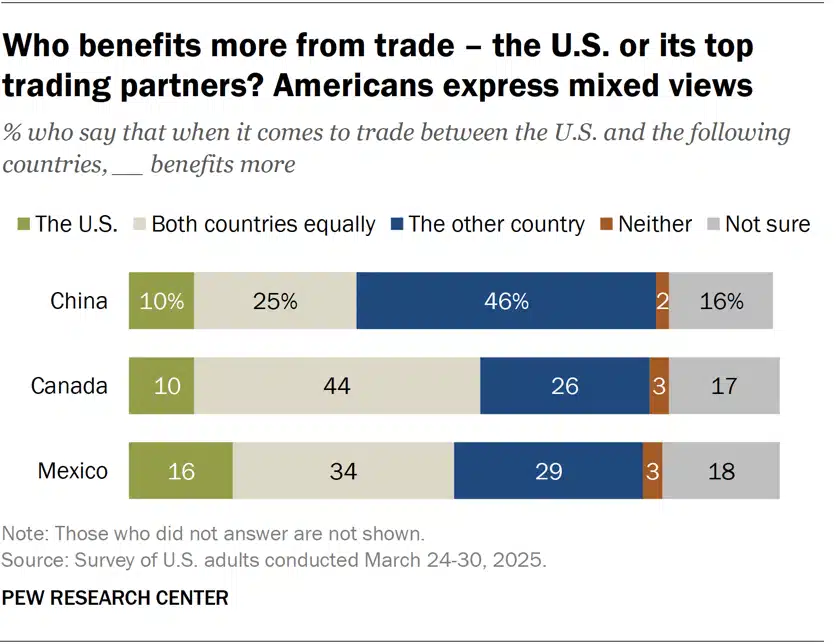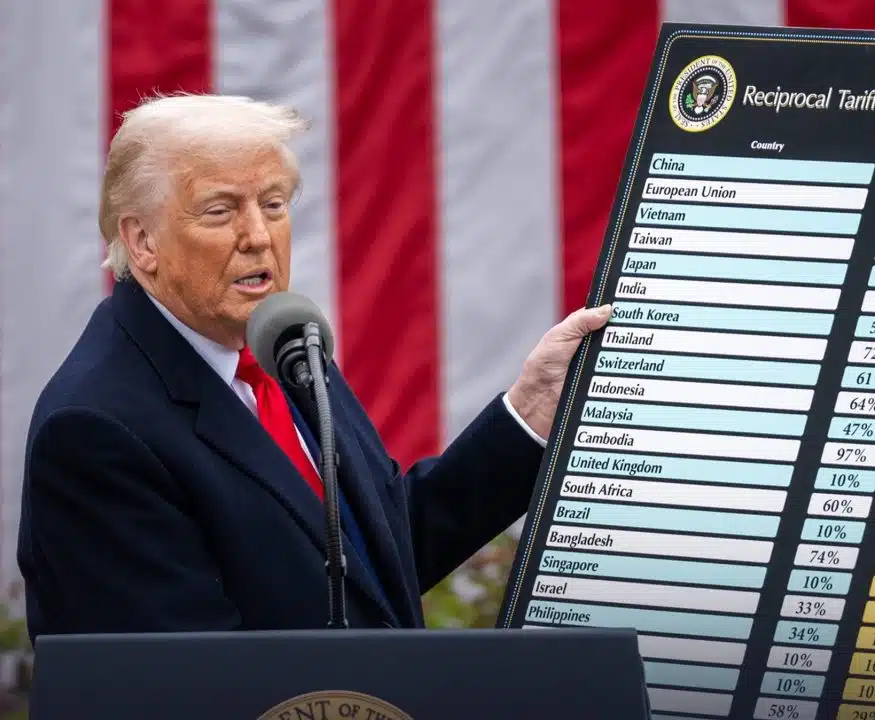U.S.-China Trade War Deepens as Trump Targets Chinese Imports

President Donald Trump’s latest salvo in the trade war has sent shockwaves through global markets and reignited tensions with China. On April 2, Trump imposed a sweeping 125% tariff on Chinese imports—an aggressive escalation in a long-simmering economic confrontation between the world’s two largest economies.
While Trump simultaneously announced a 90-day pause on tariffs for most other countries, China was notably excluded. In response, Beijing imposed 84% retaliatory tariffs on U.S. goods, calling the move “economic bullying” and accusing Washington of undermining the global trade system.
“We will fight to the end,” said China’s Ministry of Commerce.
Americans Hold Divided Views on U.S. Trade with China, Canada, and Mexico
According to a new Pew Research Center survey, Americans remain skeptical about the benefits of international trade, particularly with China:
- 46% say China benefits more from U.S.-China trade
- Only 10% say the U.S. gains more
- A quarter believe both countries benefit equally
By comparison:
- 44% say U.S.-Canada trade is mutually beneficial
- 34% see equal benefits from U.S.-Mexico trade
These findings come as Trump’s tariff-first policy redefines the economic relationships between the U.S. and its key trading partners.
Trump’s Tariff Strategy Triggers Global Market Whiplash

Trump’s surprise tariff freeze for most countries temporarily soothed investor panic, sending the S&P 500 up 9.5%, the Nasdaq up 12%, and Japan’s Nikkei up 9.1%. However, Chinese markets remained subdued, reflecting their exclusion from the pause.
Despite the rebound, bond markets, oil prices, and currency values remained volatile, highlighting persistent uncertainty.
“This chaos is a game for Trump, but it’s devastating for average Americans,” said Senate Majority Leader Chuck Schumer, who lambasted the tariffs as reckless and destabilizing.
Schumer and Gillibrand Blast Trump’s Tariffs, Demand Congressional Oversight
Senator Chuck Schumer (D-NY) criticized Trump’s “chaotic” trade policies, pointing to a $104,000 loss in average retirement savings as a result of the tariff-fueled market slump.
“The Trump slump is real,” Schumer said. “He’s destroying retirement dreams for millions of Americans.”
Senator Kirsten Gillibrand (D-NY) added that Trump’s tariffs could cost New York families nearly $4,000 annually and urged Congress to reclaim its constitutional role in trade policy. She co-sponsored the Trade Review Act, which would:
- Require 48-hour notice to Congress before imposing tariffs
- Set a 60-day expiration unless approved by joint resolution
- Allow Congress to overturn tariffs
Global Fallout: Allies Distance Themselves as China Seeks Support
China’s attempts to rally support from international allies have yielded mixed results. While leaders in the EU have engaged diplomatically, Australia and India have declined Beijing’s overtures, emphasizing independent foreign policy decisions.
Even Russia, China’s traditional ally, has not been included in Trump’s current tariff maneuvering.
“China warns that U.S. tariffs are harming the global economic order,” said China’s Foreign Ministry. “But countries are cautious to align with Beijing amid geopolitical tensions.”
Trade Deficits and Supply Chain Shocks Compound Risks
In 2024, the U.S. logged massive trade deficits with its top partners:
- $263.3 billion with China
- $179.0 billion with Mexico
- $35.7 billion with Canada
Combined, China, Canada, and Mexico account for 36.5% of all U.S. imports. Trump’s tariffs have disrupted these trade flows, causing supply chain delays, higher prices, and rising business uncertainty.
Meanwhile, Taiwan’s GDP projections dropped sharply, with forecasts as low as 1.53% growth due to the ripple effects of U.S. tariffs.
Conclusion: Trump’s Trade War Narrows to a U.S.-China Showdown
What began as a global trade crackdown has morphed into a focused economic war with China. With American public opinion split and global partners wary of aligning with either side, the U.S. trade war continues to reshape diplomacy, supply chains, and domestic politics.
The next moves — whether further escalation or unexpected diplomacy — could determine the course of the global economy in 2025 and beyond.
